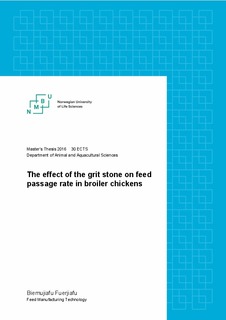| dc.description.abstract | An experiment was carried out to test the hypothesis that feeding grit to broiler
chickens would slower the passage rate of the feed throughout the digestive tract. At
the same time, the effect of grit on the performance of broilers and gizzard development
was investigated in this study.
252 one-day-old broiler chickens were randomly allocated in 4 pens. The birds
were fed commercial starter from 1-10 days, grower diets from 11 to 18 days and starter
diet diluted with 15% of whole wheat from 18-22 days. The experiment consisted of
four treatments: one control group, one zeolite group, one granite group and one marble
group.
At 5 days of age, four birds were randomly placed in each of 48 quail cages. At
5, 7 and 9 days of age, 8g, 15g and 15g of each type of grit were fed on the feed to each
of 12 cages. At 18, 19 and 20 days of age, 1g of grit per bird was given. On day 5, 11,
13, 18, 21 and 22, birds were weighed either groupwise or individually for calculating
the weight gain. On day 11, 13, 18 and 21, the feed and excreta were removed and
collected. The feed and remaining grit stones in the feed were measured to calculating
grit consumption and feed intake. The excreta were collected for observing grit
excretion. On day 13, 18 and 21, randomly selected bird from each cage was killed. The
crop content and gizzard content were collected and frozen for later laboratory analysis.
The empty gizzard weight and full gizzard weight were measured. Small intestine was
also collected and frozen for later laboratory analysis. On day 22, two birds from each
treatment were killed at 30min, 60min, 90min, 120min, 150min and 180min after
commencement of feeding to measure the feed flow rate.
There were three grit-fed groups in the experiment and a control group (nongrit-
fed group). In the result section, the data from marble-fed group was not used.
The findings in this study showed that grit had no effect on feed passage rate
(P>0.05). Feed intake, weight gain and feed: gain ratio of the birds were also not
affected by grit supplementation (P>0.05). In addition, there was no significant
difference in gizzard weight between grit-fed birds and non-grit-fed birds (P>0.05).
Grit excretion and retention were significantly different in grit-fed groups. | nb_NO |

